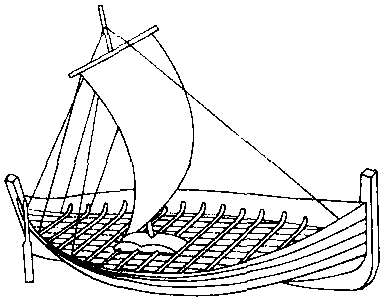1398年
明孝陵(朱元璋墓)建成。后又建石人石兽群,都以巨石雕凿而成。为建孝陵碑牌,在南京东郊阳山西麓采石场采巨型碑材三块,分别做碑座、碑身和碑额。碑座长26.5米,宽16米,厚13米,底部已凿空,仅留两处支点与山相连。碑额呈椭圆形,长20米,宽7米,厚10.7米。碑身长48.3米,宽12.20米,厚4.20米。估计碑身重5 500吨,为历代罕见的巨型碑材。
沈继孙采用新的制墨配方。用油烟代替松烟作为色料,用十两桐油烧成的烟灰与四两半牛皮胶、半两鱼胶、半两秦皮、半两苏木一起揉制。
1398年
帖木儿率军侵入印度,进占德里,屠杀当地居民达10万人。次年帖木儿离开印度时,德里已成废墟。
1398年
德国易北河—特拉弗运河竣工。
帖木儿帝国的建筑力求豪华,盛行用琉璃砖盖穹顶、鼓座、塔身、墙石。中亚和伊朗的纪念性建筑一直保持这种特色。
1400年前 中欧大部分地区盛行宗教雕版画,都为圣徒画像和圣经故事,拉丁文字说明印在画像下,亦有刻在人物口旁。这说明在古登堡铸造金属活字以前,欧洲印刷术已有一定发展。
欧洲冶炼技术进步,能在长时间保持高温的熔炉中冶成铸铁和钢。铸铁的生产对大炮、枪支、铁锚的生产有巨大作用。
欧洲普遍建筑拦河坝闸。坝闸既能导流又能通航,建造用途各不相同。荷兰阿姆斯特丹附近的坝闸是用于围海造田、排除低地积水,而意大利米兰附近的坝闸则是为通航而建的导流闸和堰坝。
欧洲造船技术停滞在海盗船阶段。其著名船舶是 “维京”海盗船(图)。该船长度为20米左右,排水量20吨左右,可乘30~40人,有一顶方帆,每舷有10~20支桨,主要动力仍靠人力划桨,船无尾舵。船的纵向构件是船底龙骨,横向构件是肋骨,船上没有甲板,没有隔舱壁,船体外板采用板缘重叠的搭接方式。
欧洲改进两轮、四轮马车的主轴,通过枢轴把旋转接头装上车架。这种改进车辆最先用于作战运输,后逐步用于交通。
1400年前后 欧洲北部平原制出能改变叶片方向的箱形和头部转动的塔形两种风车。风车旋转轴带动磨粉机等机械工作。

“维京”船
1398年
捷克宗教改革家约翰·胡斯到布拉格大学任教,并任布拉格大学哲学院院长,不久又升任校长。
1398年
明太祖朱元璋卒,皇太孙朱允炆继位,是为惠帝。太祖称帝后实行分封制,分封24个儿子和一个重孙于腹地、边境为王,“据名藩,居要害,以分制海内”。诸王中燕王朱棣拥兵10万,宁王朱权带甲8万。藩王势大威胁帝权。惠帝继位后用大臣齐泰、黄子澄计,逐步削藩。